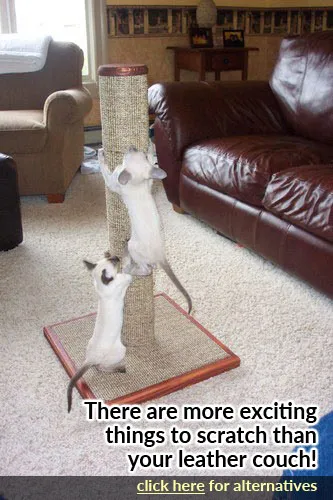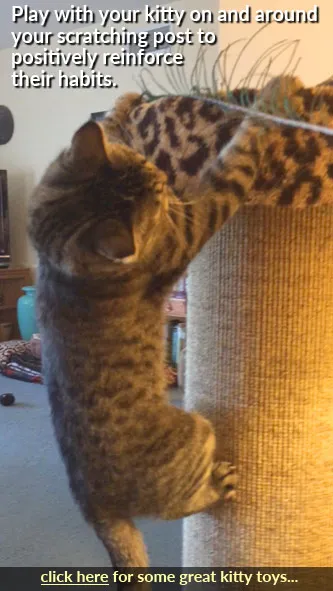Training your kitten to use a scratching post is a vital step in redirecting their natural scratching instincts away from your furniture and carpets. While it might seem like a challenge, understanding your cat’s behavior and employing the right techniques can make the process significantly easier. This guide will walk you through selecting the best scratching post, strategic placement, and effective training methods to ensure your feline friend embraces their designated scratching areas.
Choosing the Right Scratching Post and Placement
The success of training your kitten to use a scratching post begins with choosing the right product and placing it in an optimal location. Cats have innate reasons for scratching, and understanding these can guide your decisions.
Understanding Cat Scratching Behaviors:
- Territorial Marking: Cats scratch to communicate with other cats. The visual marks and scent from glands in their paws leave messages. Therefore, scratching posts should be placed in prominent, high-traffic areas where your cat can effectively “advertise” their territory. While initial placement might be in a visible spot, you can gradually move the post to a more aesthetically pleasing location once your cat is accustomed to using it.
- Muscle Stretching: Scratching is also a way for cats to stretch their muscles, particularly in their shoulders, toes, and feet. This often happens after waking up, making areas near their favorite sleeping spots ideal for placing scratching posts.
- Attraction to Existing Scratch Areas: If your cat has already shown a preference for scratching a particular spot on your carpet or furniture, place a scratching post or pad in that exact location. This redirects their behavior to the appropriate surface. You can further deter them from the furniture by temporarily covering the area with a well-tucked blanket and placing the scratching post directly in front of it. Once they consistently use the post, you can slowly reposition it.
Providing multiple scratching posts in different locations throughout your home significantly increases the chances of your furniture remaining unscathed. Observe where your cat currently scratches – vertical, horizontal, or angled surfaces, in corners, or under beds – and use this information to select and place posts that cater to their specific preferences.
 A kitten curiously looking at a scratching post.
A kitten curiously looking at a scratching post.
Encouraging Your Kitten’s Interest in the Scratching Post
If your kitten doesn’t immediately take to their new scratching post, don’t be discouraged. A little coaxing can help them discover how enjoyable and satisfying it is.
- Catnip: For many cats, catnip is an irresistible attractant. Sprinkle some dried catnip on and around the scratching post. When your cat interacts with it, they may start kneading, which can lead them to discover the post’s scratching potential.
- Playtime: Incorporate the scratching post into your kitten’s playtime. Using a wand toy, encourage your kitten to reach and grab at the toy while on the post. You can also place a favorite toy on top of the post to entice them to climb and explore. This positive association can quickly make the post a favorite item.
- Horizontal Placement: For kittens new to scratching posts, try laying the post on its side initially. Combine this with catnip and play. Once they are comfortable scratching in this position, gradually upright the post.
- Multiple Posts for Multiple Cats: If you have more than one cat, provide multiple scratching posts. Encouraging interactive play around the posts with small toys can help all your cats engage with them.
- Treats: Reward your kitten’s investigation of the post with treats. Initially, a treat for sniffing or rubbing against the post is sufficient. Progress to rewarding them for placing their paws on it, and eventually for scratching. Placing treats on top can also encourage climbing. Positive reinforcement makes the scratching post a highly desirable object. You can also use products like Feliway, which mimics calming feline pheromones, on household items they tend to scratch, alongside your training efforts.
 Kittens playing around a scratching post.
Kittens playing around a scratching post.
It’s important to note that forcibly grabbing your kitten’s paws and placing them on the post is generally ineffective and can lead to avoidance. Kittens, however, may be more amenable to this, especially if they lack an older cat to model behavior. Play remains a highly effective method for kittens.
The Ineffectiveness of Negative Training Methods
Avoid using negative reinforcement techniques such as spraying your cat with water, making loud noises, or any form of punishment. These methods are rarely effective with cats and can lead to increased stress, anxiety, and undesirable behaviors like inappropriate urination or defecation, or even more scratching. Instead, focus on positive reinforcement, rewarding the desired behavior of using the scratching post.
If your kitten seems uninterested in the scratching post despite your best efforts, try relocating it to a different spot. A location near a window, where they can watch birds or other outdoor activity, can sometimes spark their scratching instinct.
With patience, consistent positive reinforcement, and strategic placement, your kitten will soon learn to enthusiastically use their scratching post, leaving your furniture and carpets untouched. This positive engagement helps them fulfill their natural needs while maintaining harmony in your home. train cat scratcher.
